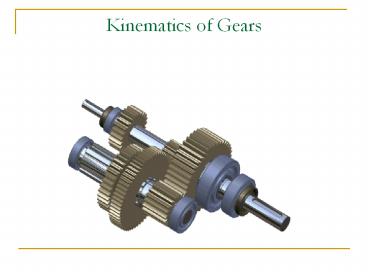Spur gear - PowerPoint PPT Presentation
Title:
Spur gear
Description:
Classification of gear – PowerPoint PPT presentation
Number of Views:2377
Title: Spur gear
1
Kinematics of Gears
2
Gears!
- Gears are most often used in transmissions to
convert an electric motors high speed and low
torque to a shafts requirements for low speed
high torque - Speed is easy to generate, because voltage is
easy to generate - Torque is difficult to generate because it
requires large amounts of current - Gears essentially allow positive engagement
between teeth so high forces can be transmitted
while still undergoing essentially rolling
contact - Gears do not depend on friction and do best when
friction is minimized - Basic Law of Gearing
- A common normal (the line of action) to the
tooth profiles at their point of contact must, in
all positions of the contacting teeth, pass
through a fixed point on the line-of-centers
called the pitch point - Any two curves or profiles engaging each other
and satisfying the law of gearing are conjugate
curves, and the relative rotation speed of the
gears will be constant
3
Spur Gears
- Teeth are parallel to the axis of the gear
- Advantages
- Cost
- Ease of manufacture
- Availability
- Disadvantages
- Only works with mating gear
- Axis of each gear must be parallel
4
Helical Gears
- Teeth are at an angle to the gear axis (usually
10 to 45) called helix angle - Advantages
- Smooth and quiet due to gradual tooth engagements
(spur gears whine at high speed due to impact).
Helical gears good up to speeds in excess of
5,000 ft/min - More tooth engagement allows for greater power
transmission for given gear size. - Parallel to perpendicular shaft arrangement Fig
8.2 - Disadvantage
- More expensive
- Resulting axial thrust component
5
Helical Gears
- Mating gear axis can be parallel or crossed
- Can withstand the largest capacity at 30,000 hp
6
Worm Gears
worm gear
- Gears that are 90 to each other
- Advantages
- Quiet / smooth drive
- Can transmit torque at right angles
- No back driving
- Good for positioning systems
- Disadvantage
- Most inefficient due to excessive friction
(sliding) - Needs maintenance
- Slower speed applications
worm
7
Bevel Gears
- Gear axis at 90, based on rolling cones
- Advantages
- Right angle drives
- Disadvantages
- Get axial loading which complicates bearings and
housings
8
Spiral Bevel Gears
- Same advantage over bevel gears as helical gears
have over spur gears!! - Teeth at helix angle
- Very Strong
- Used in rear end applications (see differentials)
9
Why Use Gears?
- Reduce speed
- Increase torque
- Move power from one point to another
- Change direction of power
- Split power
Generally this functionality is accomplished by
many gears mounted in a gear box!
10
How a differential works http//en.wikipedia.org/
wiki/Differential_(mechanical_device)

